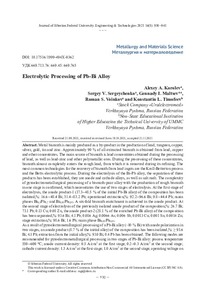Электролитическая переработка Pb-Bi- сплава
Скачать файл:
URI (для ссылок/цитирований):
https://elib.sfu-kras.ru/handle/2311/145046Автор:
Королев, А. А.
Сергейченко, С. В.
Мальцев, Г. И.
Воинков, Р. С.
Тимофеев, К. Л.
Korolev, Alexey A.
Sergeychenko, Sergey V.
Maltsev, Gennady I.
Voinkov, Roman S.
Timofeev, Konstantin L.
Дата:
2021-12Журнал:
Journal of Siberian Federal University. Engineering & Technologies 2021; Журнал Сибирского федерального университета 2021 14 (8)Аннотация:
Металлический висмут главным образом производится как побочный продукт
при получении свинца, вольфрама, меди, серебра, золота, олова и цинка. Из свинцовых, медных
и других концентратов получают ~90 % всего добываемого висмута. Основной источник
висмута ‒ свинцовые концентраты, получаемые при переработке свинцовых, а также свинцово-цинковых
и других полиметаллических руд. При переработке этих концентратов висмут почти
полностью попадает в свинец черновой, из которого удаляется при его рафинировании. Наиболее
распространенные технологии для восстановления висмута из свинцовых слитков ‒ процесс
Kroll-Betterton
и электролитический процесс Betts. При электролизе Bi–Pb-сплава
установлено
выделение трех продуктов – анодного и катодного сплавов, а также солевого плава. Подтверждена
сложность пироэлектрометаллургической переработки бедного по висмуту сплава с получением
висмута чернового в одну стадию, что обусловливает необходимость использования двух стадий
электролиза. На I стадии электролиза выделен анодный продукт‑1 (17,3–48,5 % от исходного
Pb-Bi-сплава) состава,%: 16,6–48,4 Bi; 51,4–83,2 Pb; операционное извлечение,%: 92,2–96,6 Bi;
9,8–44,4 Pb; основные фазы Bi0,3Pb0,7 и Bi0,95Pb0,05. В анодном продукте достигается шестикратное
обогащение по висмуту. На II стадии электролиза ранее выделенного анодного продукта состава,%:
26,7 Bi; 73,1 Pb; 0,13 Cu; 0,08 Zn, получен анодный продукт‑2 (28,1 % от обогащенного Pb-Bi-
сплава) состава,%: 93,6 Bi; 4,1 Pb; 0,086 Ag; 0,0066 As; 0,006 Sb; 0,0013 Cu; 0,001 Sn; 0,0014 Zn;
стадиальное извлечение,%: 98,6 Bi; 1,6 Pb; основная фаза Bi0,95Pb0,05.
В результате пироэлектрометаллургической переработки Pb-Bi
сплава (~10 % Bi) с анодной
поляризацией в две стадии получен анодный продукт (8,7 % от исходного сплава) состава,%:
≥ 93,6 Bi; 4,1 Pb; извлечение из исходного сплава,%: 93,0 Bi; 0,4 Pb. Рекомендованы для
пироэлектрометаллургической переработки в две стадии Pb-Bi-
сплава
следующие режимы:
температура процесса 550–600 ºС; анодная плотность тока: на первой стадии – 0,5 А/см2; на второй
стадии 0,2–0,3 А/см2; катодная плотность тока: на первой стадии 1,5 А/см2; на второй стадии
1,0 А/см2; рабочее напряжение на ванне: на первой стадии 8–12 В; на второй стадии 5–8 В; состав
электролита на обеих стадиях,%: 7 NaCl; 35 KCl; 18 PbCl2; 40 ZnCl2; количество электролита,
выводимого на переработку: на первой стадии – 10 % от массы Pb-Bi-
сплава
после щелочной
обработки; на второй стадии – 10 % от массы анодного продукта первой стадии Metal bismuth is mainly produced as a by-product in the production of lead, tungsten, copper, silver, gold, tin and zinc. Approximately 90 % of all extracted bismuth is obtained from lead, copper and other concentrates. The main source of bismuth is lead concentrates obtained during the processing of lead, as well as lead-zinc and other polymetallic ores. During the processing of these concentrates, bismuth almost completely enters the rough lead, from which it is removed during its refining. The most common technologies for the recovery of bismuth from lead ingots are the Kroll-Betterton process and the Betts electrolytic process. During the electrolysis of the Bi-Pb alloy, the separation of three products has been established, they are anode and cathode alloys, as well as salt melt. The complexity of pyroelectrometallurgical processing of a bismuth-poor alloy with the production of rough bismuth in one stage is confirmed, which necessitates the use of two stages of electrolysis. At the first stage of electrolysis, the anode product‑1 (17.3–48.5 % of the initial Pb-Bi alloy) of the composition has been isolated,%: 16.6–48.4 Bi; 51.4–83.2 Pb; operational extraction,%: 92.2–96.6 Bi; 9.8–44.4 Pb; main phases Bi0,3Pb0,7 and Bi0,95Pb0,05. A six-fold bismuth enrichment is achieved in the anode product. At the second stage of electrolysis of the previously isolated anode product of the composition,%: 26.7 Bi; 73.1 Pb; 0.13 Cu; 0.08 Zn, the anode product‑2 (28.1 % of the enriched Pb-Bi alloy) of the composition has been separated,%: 93.6 Bi; 4.1 Pb; 0.086 Ag; 0.0066 As; 0.006 Sb; 0.0013 Cu; 0.001 Sn; 0.0014 Zn; stage extraction,%: 98.6 Bi; 1.6 Pb; main phase Bi0,95Pb0,05.
As a result of pyroelectrometallurgical processing of a Pb-Bi alloy (~10 % Bi) with anode polarization in two stages, an anode product (8.7 % of the initial alloy) of the composition has been isolated,%: ≥ 93.6 Bi; 4.1 Pb; extraction from the initial alloy,%: 93.0 Bi; 0.4 Pb has been obtained. The following modes are recommended for pyroelectrometallurgical processing in two stages of Pb-Bi alloy: process temperature 550–600 °C; anode current density: 0.5 A/cm2 at the first stage; 0.2–0.3 A/cm2 at the second stage; cathode current density: 1.5 A/cm2 at the first stage; 1.0 A/cm2 at the second stage; operating voltage on the tub: at the first stage 8–12 V; at the second stage 5–8 V; the composition of the electrolyte at both
stages,%: 7 NaCl; 35 KCl; 18 PbCl2; 40 ZnCl2; the amount of electrolyte output for processing: at the
first stage – 10 % of the mass of the Pb-Bi
alloy after alkaline treatment; at the second stage – 10 % of
the mass of the anode product of the first stage

